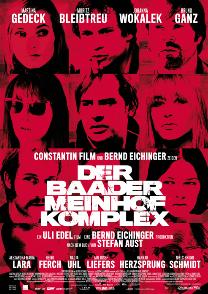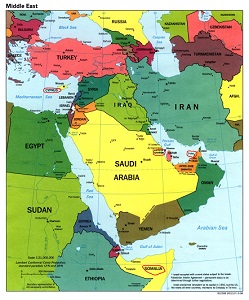 1960 through the 1970s was a time of global disturbances—the American-Soviet Cold War, the Vietnam War, the Palestine refugee problem, China’s Cultural Revolution, Algeria’s independence, the South American Dirty War, and the assassinations of President Kennedy and Martin Luther King Jr.—but I wonder how many people today remember the terrorism in Europe by the Red Army Faction from Germany. Around 1970, one-third of young Germans in their twenties sympathized with the Red Army Faction, and the uprising of this youth was a great threat to the West Germany government. The youth supporting the Red Army are now in their 60s and 70s. Young Germans who had a strong sense of justice and received a higher education became involved with the left-wing movement during the 1960s, burning with idealism; in the 1970s, the movement split between non-violent and armed resistance. This movie The Baader Meinhof Complex depicts the process of radicals of the Red Army rapidly transforming into a terrorist group. It is not depicted in the movie, but the Berlin Wall collapses in the ‘80s and people eventually became aware that the socialist system was a failure.
1960 through the 1970s was a time of global disturbances—the American-Soviet Cold War, the Vietnam War, the Palestine refugee problem, China’s Cultural Revolution, Algeria’s independence, the South American Dirty War, and the assassinations of President Kennedy and Martin Luther King Jr.—but I wonder how many people today remember the terrorism in Europe by the Red Army Faction from Germany. Around 1970, one-third of young Germans in their twenties sympathized with the Red Army Faction, and the uprising of this youth was a great threat to the West Germany government. The youth supporting the Red Army are now in their 60s and 70s. Young Germans who had a strong sense of justice and received a higher education became involved with the left-wing movement during the 1960s, burning with idealism; in the 1970s, the movement split between non-violent and armed resistance. This movie The Baader Meinhof Complex depicts the process of radicals of the Red Army rapidly transforming into a terrorist group. It is not depicted in the movie, but the Berlin Wall collapses in the ‘80s and people eventually became aware that the socialist system was a failure.
Because this movie depicts many young people from the Red Army as well as the authorities that countered them over a 10-year period, violent acts occur one after another in the movie and the depictions of individuals are superficial. Moreover, the movie just depicts the facts with a documentary touch and the most important questions of, “Why did the German youth of the ‘60s join the armed Red Army Faction or support it? Why did the Red Army that had such strong support collapse?” are not depicted. Also, this movie is a little difficult to understand for people who don’t really know German history or don’t remember that extremists exist in developed countries like Germany. This movie assumes that the audience knows history and does not explain the details at all. I investigated some of the background to this movie.
The movie begins with the Shah of Iran visiting West Berlin in 1967. A peaceful protest demonstration led by students and Iranians who had fled because of the Shah’s dictatorship changes into a riot when a police officer shoots and kills a student. Ulrike Meinhof was a famous left-wing journalist, but she was shocked by this case and became more radical in her ideology. Her husband was also an editor at a left-wing magazine, but he opposed violent acts so the two divorced.
Gudrun Ensslin, daughter of a pastor, was a bright honors student. She was working toward her doctorate at one of Germany’s top universities—the Free University of Berlin—and hoped to posthumously publish the manuscripts of her fiancé’s father, a former Nazi. Like her own father who possessed sympathy to social problems as a pastor, she believed in moderate reform through the Congress, but her life changed when she met Andreas Baader. She abandoned her fiancé and their child and eloped with Andreas.
Andreas Baader dropped out of high school and was the kind of man who repeatedly committed every crime. He was a unique individual among the radicals, many of whom had a background of high education, but he was strongly charismatic and he and Gudrun Ensslin led the radicals to terrorism and criminal acts.
Ensslin and Baader were arrested for setting a department store on fire. Meinhof visited the imprisoned Ensslin for the news story and the two immediately had a mutual understanding. Meinhof, Ensslin, and Baader founded the Baader-Meinhof Group, which later developed into the Red Army Faction. After staying and receiving military training at the guerilla training camp of the Palestinian Liberation Organization based in Jordan in those days, they succeeded in acts of terrorism and bank robberies to fund their activity, one after another, and became a great threat to the government of West Germany. The leaders of the Red Army Faction including Meinhof, Ensslin, and Baader were arrested in 1971, but through meetings with their lawyers Klaus Croissant and Siegfried Haag, they trained Red Army soldiers while still imprisoned and brought up the second and third generations of Red Army Faction activists.
The next generations of the Red Army Faction rapidly became more radical, kidnapping and hijacking for the sake of the release of Baader and the others. Famous acts of terrorism included the kidnapping and killing of an Israeli team member from the Olympic Village of the Munich Olympics in 1972, the occupation and blowing up of the German embassy in Sweden in 1975, and the assassination of Siegfried Buback and Jürgen Ponto, the kidnapping and killing of businessman Hanns Martin, and the hijacking of Lufthansa Airlines Flight 181 in 1977. The level of violence of the Red Army reached its peak in the late 1970s; this series of terrorist acts is called the “German Autumn” and the Red Army lost the last of its support from citizens. Albrecht, a member of the Red Army, participated in the terrorist act against Dresdner Bank—the failed kidnapping and subsequent murder of the banks’ President Jürgen Ponto, who was Albrecht’s father’s friend as well as her godfather. “Black September”—a Palestinian armed group that was expelled from Jordan, moved to Lebanon, and became more violent—allied with and fought alongside the Red Army Faction.
 The leader of the Lufthansa Airlines Flight 181 hijacking, a “Black September” soldier, demanded of the West Germany government that eleven Red Army Faction first generation members be released, as well as $150 million. When Palestinians had become refugees, international opinion—especially Arab countries—became sympathetic to Palestinians and their liberation movement, but these sympathies began to shift following this incident. The Palestinian Liberation Organization already lost support from Jordan and Syria. The hijacked aircraft was passed around to Larnaca (Republic of Cyprus), Bahrain, and Dubai, but after Dubai, no other airport in the Arabian Peninsula provided permission for the plane to land. After having to make an emergency stop in Aden, Yemen when the fuel was all used up, the hijacked plane eventually landed in Mogadishu, Somalia where it is apprehended by the German government. Immediately after this hijacking failure, the first generation Red Army Faction leaders in jail committed suicide.
The leader of the Lufthansa Airlines Flight 181 hijacking, a “Black September” soldier, demanded of the West Germany government that eleven Red Army Faction first generation members be released, as well as $150 million. When Palestinians had become refugees, international opinion—especially Arab countries—became sympathetic to Palestinians and their liberation movement, but these sympathies began to shift following this incident. The Palestinian Liberation Organization already lost support from Jordan and Syria. The hijacked aircraft was passed around to Larnaca (Republic of Cyprus), Bahrain, and Dubai, but after Dubai, no other airport in the Arabian Peninsula provided permission for the plane to land. After having to make an emergency stop in Aden, Yemen when the fuel was all used up, the hijacked plane eventually landed in Mogadishu, Somalia where it is apprehended by the German government. Immediately after this hijacking failure, the first generation Red Army Faction leaders in jail committed suicide.
I think the new postwar generation after World War II was trying to find a much-needed solution to the problems left behind or even created by their parents’ generation in those days, and turned to left-wing ideology to do so. However, the movement that began with idealism was gradually forced to choose between violent or non-violent methods. Resorting to violence may have looked like a quick and easy way to get a solution, but it was not a lasting solution.
The director of this movie was Uli Edel. Ulrike Meinhof was performed by Martina Gedeck who also starred in Mostly Martha (Catherine Zeta-Jones starred in the Hollywood remake No Reservations) and The Lives of Others. The movie was nominated for the Academy Award for Best Foreign Language Film, but the prize that year ended up going to Japan’s Departures.
